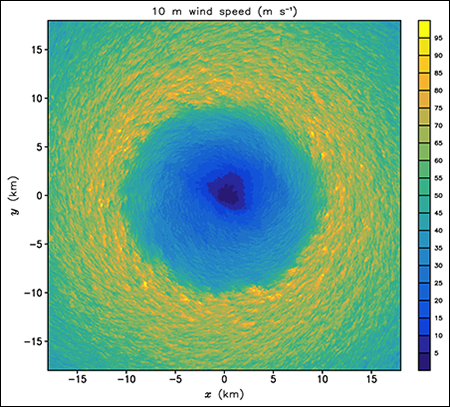Source: Geophysical Research Letters
In September 2016, scientists at the U.S. Department of Energy calculated that offshore wind turbines could produce more than 7,200 terawatt hours of energy generation per year, nearly double the nation’s current electricity use. Some challenges lie in the way of tapping into the wind’s enormous potential, however, including concerns about how wind turbine farms may affect marine life.
Now a new study highlights another potential barrier: Current wind turbine design standards do not yet have hurricane-specific guidelines and thus would not withstand a direct hit from a category 5 storm, such as Hurricane Katrina.
Many studies have been conducted about offshore wind speeds during a hurricane, but very few have occurred at turbine hub height (~100 meters above sea level). Reconnaissance flights flown directly through storms often gather measurements but can’t safely descend to the height of most wind turbines. To make up for this, Worsnop et al. used a computer model of atmospheric eddies to estimate gusts of wind at that height in the most damaging part of a hurricane, the small eye wall bordering the storm’s low-pressure center.

The study showed that category 5 hurricanes produce gusts of wind as powerful as 100 meters per second, far higher than the 70 meter per second threshold for gusts that current turbine design standards—set by the International Electrotechnical Commission (IEC)—require for nonhurricane conditions. Average wind speeds simulated in the study can exceed 90 meters per second over 10-minute intervals within the eye wall of a hurricane; design standards require instrumentation to withstand speeds of only 50 meters per second over the same time. The team also found that the wind’s direction could shift up to 55° along the turbine’s rotors within a minute: a level of strain that could lead to mechanical failure if turbines are not designed accordingly.
The eye wall makes up only a fraction of a hurricane’s total area, the team points out, and category 5 hurricanes are relatively rare, with most years having one or no category 5 hurricanes forming in the Atlantic Ocean. But previous studies have shown that an eye wall can span 20 kilometers—large enough to encompass an entire wind farm in the event of a direct hit. The new study could help wind developers improve the design of offshore turbines and consider financial tools like insurance to mitigate the risk of building wind farms in regions where category 5 hurricanes can occur. (Geophysical Research Letters, https://doi.org/10.1002/2017GL073537, 2017)
—Emily Underwood, Freelance Writer
Citation:
Underwood, E. (2017), Offshore wind turbines can’t yet withstand category 5 hurricanes, Eos, 98, https://doi.org/10.1029/2017EO078613. Published on 08 August 2017.
Text © 2017. The authors. CC BY-NC-ND 3.0
Except where otherwise noted, images are subject to copyright. Any reuse without express permission from the copyright owner is prohibited.

